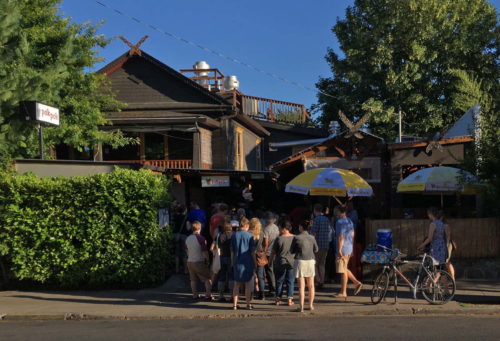We drove down to Portland for the July 4 weekend. Portland holds many attractions: A thriving food scene; access to Mount Hood, the Columbia River, and the coast; and no sales tax. On Saturday we hit three P’s: Powell’s, Penzey’s, and Pok Pok.
Powell’s is one of the largest independent bookstores in the country. It takes up a whole city block in downtown Portland, and has branches around the city and the suburb of Beaverton. The last two times we’ve visited Portland, I’ve chosen a hotel that was close to Powell’s. Naturally, I made a beeline for the cookbook section in the orange room. We showed admirable restraint: Three cookbooks between us, and a book on eating in Vietnam. My ultimate bucket list trip is to eat my way from Hanoi to Hue to Ho Chi Minh City and then hang a right turn up the Mekong River into Cambodia. Coincidentally, one of the cookbooks I bought contains recipes from a Cambodian sandwich shop in New York.
As we were walking back to the hotel from Powell’s, I noticed a familiar sign across the street: Penzey’s Spices. Their store in Seattle closed in January; since then, our spice shopping list has grown exponentially. We bought enough that we got three freebies: Turkish seasoning, chili powder, and cracked rosemary. According to the proprietor of the Portland shop, the Seattle store closed because the landlord jacked up the rent. This is a common problem for residents and businesses alike. (Note to Bill Penzey: There are several vacant storefronts in downtown Bothell, where the rent is not as high as in downtown Seattle. Check out our little hometown!)
Dinner was at the Thai restaurant Pok Pok. The owner and chef is an American, Andy Ricker, who has studied the cuisines of northern Thailand. The restaurant is not an architectural marvel; in fact, it’s more like an open-air restaurant in Chiang Mai. If you’re expecting gloppy coconut milk-based curries or pad Thai at Pok Pok, forget about it. Northern Thai cuisine is more salad- and grill-based. However, the signature dish of Pok Pok is its Vietnamese deep-fried chicken wings. These are a medley of fish sauce, sugar, and lots of garlic. After a bowl of wings, we had pork satays and a sausage/pork rind/vegetable plate. On the latter, Julian picked up what he thought was a half-moon of cantaloupe, only to discover that it was kabocha squash. Pok Pok does not take reservations. We got there shortly after 5 pm, and had to wait 45 minutes for a table. When we left, the wait was over 2 hours.
Pok Pok has branches in Los Angeles and New York, but not in Seattle (yet). Yo, Andy, show your neighbors to the north a little love!

Pok Pok. The line was at low tide at this time.

The “interior” of Pok Pok. Notice the french fry lamps above the tables for colder evenings. (Yes, the restaurant is open to the elements.)
More adventures in Portland to come.

Recent Comments